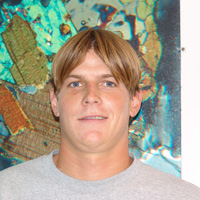 The geology of Isla Natividad, Baja California Sur, MexicoJon Sainsbury Wednesday, May 9th, 2008 |
||
|
||
| ABSTRACT Isla Natividad is a Pacific island that sits just offshore to the west of Punta Eugenia on the Vizcaino Peninsula of Baja California. The geology of Baja California here preserves remnants of a Mesozoic Subduction zone-magmatic arc as well as Cenozoic rocks and structures that record the evolution of the region from a convergent margin to a strike slip dominated plate boundary. Isla Natividad is underlain almost entirely by sedimentary rocks of the Late Jurassic-Early Cretaceous Eugenia Formation which comprises part of the thick forearc basin marine stratigraphic assesmblages in the Vizcaino region. The type locality of the Eugenia Formation is at the fault bounded western tip of the Vizcaino Peninsula (Punta Eugenia), and it has also mapped on Cedros Island and recognized in reconnaissance on Isla Natividad. The goal of this study is to provide basic mapping and descriptions of the geology of Isla Natividad. Geologic mapping conducted in this study reveals that the main part of the island is dominated by gently southwest dipping strata that include conglomerate, turbidite and mudstone units. Conglomerate outcrops mainly on the NE coast of the island. It is dominated by cobble-boulder clast sizes that range from 0.1-0.5 meters. The maximum clast size observed is 0.75 meters. Conglomerates are clast-supported, massive, well-indurated and weathered to a dark grey color. Clast imbrication is locally present but there is no internal bedding or size grading. More than 50% of the clasts are rounded quartzite clasts. Other clast compositions include andesite, chert and subangular intraformational sandstone and mudstone rip-up clasts. Turbidite beds are well exposed along the coast in places and have an average bedding strike and dip of N50W 30SW. They are characterized by laterally continuous uniform thickness beds with classic sediment gravity flow structures such as graded bedding and parallel laminations. They comprise 5-8 cm thick beds of fine-grained feldspathic-lithic sandstone and 2-4 cm beds of grayish siltstone to mudstone. Sandstone and siltstone weathers to a green color. The mudstone unit makes up the higher elevations along the crest of the island and have an average orientation of N40W 20SW. It outcrops poorly except along the coast but consists of dark grayish-green siltstone, brownish heavily fractured mudstone, blackish shale, and occasional light gray claystone. Beds range in thickness from several millimeter thick laminae up to 1-4 centimeters beds. Desert vegetation including jumping choya cactus prefer this fine grained unit so that the distribution of the units can be traced using Google Earth images. Massive poorly bedded sandy breccia occurs throughout the island. It consists of 50 percent angular gravel clasts in a muddy-fine grained sandy matrix. Occasional size grading was noted with large 1 meter diameter gray shale and sandstone lense rip-up boulders concentrated near tops of beds. This unit has occasional interbeds of sandstone with 4-6 centimeter thick beds and 1 centimeter laminations. The average orientations of the interbeds were N50W 40SW. This massive unit was interpreted as debris flows and near-shore sediment slumps. Other map units on the island include a whitish shell dominated beach/channel sands. This unit was classified as a shallow dipping well-sorted feldspathic shelly arenite with cross-bedded laminations and poor to absent bedding planes. It was bounded by erosional unconformity contacts. A fine-grained resistant lithic sandstone to siltstone was found on the southern tip of the island and bounded by coast and a southern fault zone. These units may be correlative to the Pliocene Almejas Formation which is widespread through the Vizcaino region. In the southern part of the island a major fault that strikes N70E cuts off the southern tip of the island. This fault is well exposed on the beach at the SW corner of the island where is comprises a broad shear zone (~20 m wide) with folded, faulted and disrupted strata. Strike and dips in units immediately to the north side of the fault are discordant to regional bedding strike and dip on the island. Two other potential faults with NE strikes were also mapped farther north on the island. The NE strike of this faulting is highly discordant to the strike of major northwest trending Cenozoic faults along this part of the Pacific margin. These include the San Benito and Tosco-Abreojos Faults that are believed to have accommodated Pacific-North America relative plate motion from ~12-6 Ma before the plate boundary jumped eastwards into its present position in the Gulf of California. The strong discordance of the Natividad structures to the NW trend of the Baja margin here suggests these faults may be conjugate shear zones within this system as R’ left lateral faults. Sub-horizontal slickensides were observed in the fault-breccia zone. These faults could also be reverse-thrust faults as the fault zone shows evidence of compression and the dip of the fault was measured to be 66 degrees. Using an average N32-42W trend of the transform boundary this puts these faults striking almost perpendicular to the principle stress direction of the Pacific plate sliding north-westward. This study is only a reconnaissance survey of the island geology. However it confirms the presence of the Eugenia Formation and documents abundant quartzite which indicates a continental provenance for the Eugenia basin. The N70E trending faults are interpreted as Cenozoic faults related to major NW trending structures along this part of the Pacific margin. |

